伊丽莎白一世女王英文版
- 格式:ppt
- 大小:158.00 KB
- 文档页数:10
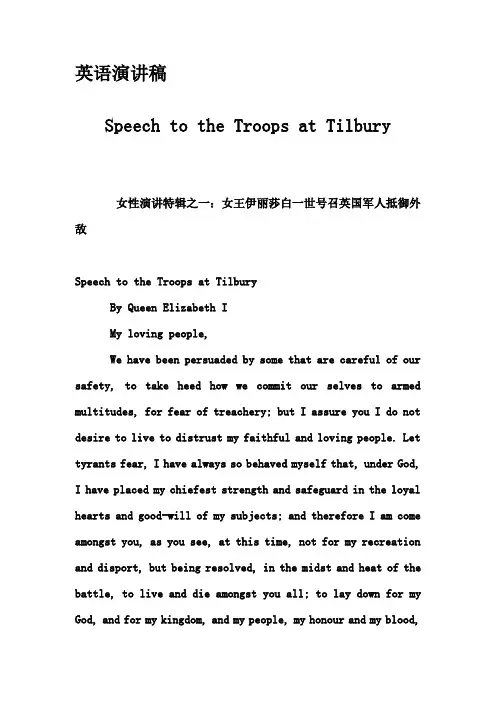
英语演讲稿Speech to the Troops at Tilbury女性演讲特辑之一:女王伊丽莎白一世号召英国军人抵御外敌Speech to the Troops at TilburyBy Queen Elizabeth IMy loving people,We have been persuaded by some that are careful of our safety, to take heed how we commit our selves to armed multitudes, for fear of treachery; but I assure you I do not desire to live to distrust my faithful and loving people. Let tyrants fear, I have always so behaved myself that, under God, I have placed my chiefest strength and safeguard in the loyal hearts and good-will of my subjects; and therefore I am come amongst you, as you see, at this time, not for my recreation and disport, but being resolved, in the midst and heat of the battle, to live and die amongst you all; to lay down for my God, and for my kingdom, and my people, my honour and my blood,even in the dust. I know I have the body but of a weak and feeble woman; but I have the heart and stomach of a king, and of a king of England too, and think foul scorn that Parma or Spain, or any prince of Europe, should dare to invade the borders of my realm; to which rather than any dishonour shall grow by me, I myself will take up arms, I myself will be your general, judge, and rewarder of every one of your virtues in the field. I know already, for your forwardness you have deserved rewards and crowns; and We do assure you in the word of a prince, they shall be duly paid you. In the mean time, my lieutenant general shall be in my stead, than whom never prince commanded a more noble or worthy subject; not doubting but by your obedience to my general, by your concord in the camp, and your valour in the field, we shall shortly have a famous victory over those enemies of my God, of my kingdom, and of my people.。
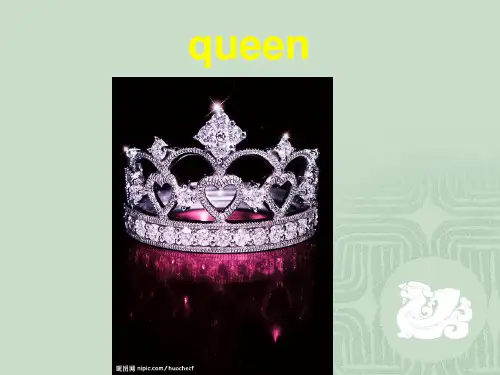
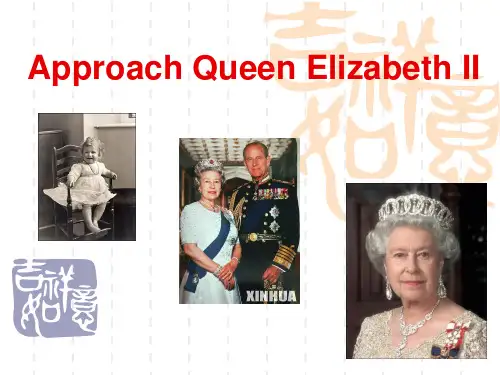
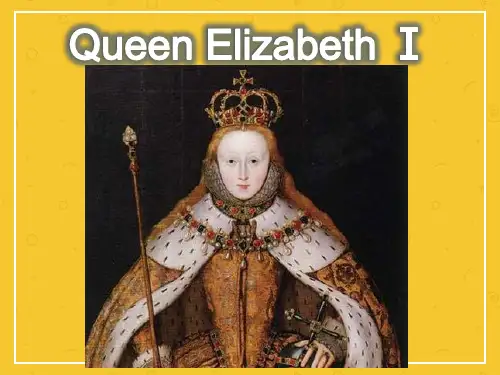

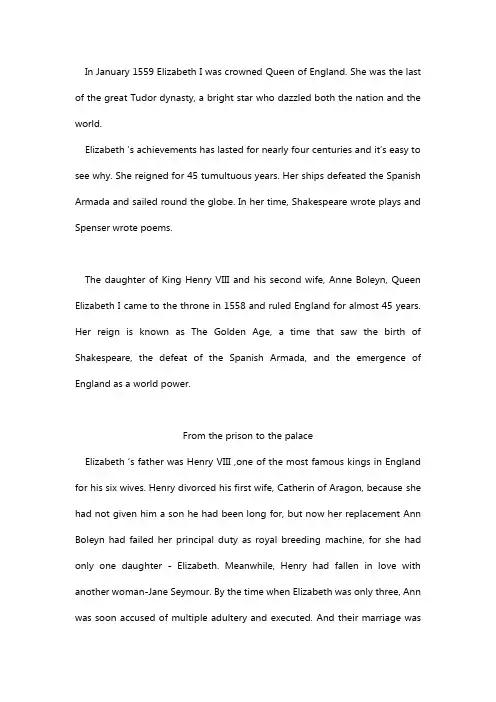
In January 1559 Elizabeth I was crowned Queen of England. She was the last of the great Tudor dynasty, a bright star who dazzled both the nation and the world.Elizabeth ‘s achievements has lasted for nearly four centuries and it’s easy to see why. She reigned for 45 tumultuous years. Her ships defeated the Spanish Armada and sailed round the globe. In her time, Shakespeare wrote plays and Spenser wrote poems.The daughter of King Henry VIII and his second wife, Anne Boleyn, Queen Elizabeth I came to the throne in 1558 and ruled England for almost 45 years. Her reign is known as The Golden Age, a time that saw the birth of Shakespeare, the defeat of the Spanish Armada, and the emergence of England as a world power.From the prison to the palaceElizabeth ‘s father was Henry VIII ,one of the most famous kings in England for his six wives. Henry divorced his first wife, Catherin of Aragon, because she had not given him a son he had been long for, but now her replacement Ann Boleyn had failed her principal duty as royal breeding machine, for she had only one daughter - Elizabeth. Meanwhile, Henry had fallen in love with another woman-Jane Seymour. By the time when Elizabeth was only three, Ann was soon accused of multiple adultery and executed. And their marriage wasdecleared null and void. Elizabeth was now illegitimate and unable to inherit the throne. So instead of the Right High and Mighty Princess, the Lady Elizabeth, inheritrix of the crown of England, she became the Lady Elizabeth, the King’s second bastard daughter. Although was brought up in the country away from the royal court, she studies languages from the age of four. She became fluent in French, Italian, Latin and Greek.In 1544, Henry reinstated Elizabeth and Mary in the succession. No woman had ever sat on the throne before. Now if Edward (Jane Seymour ’ s son) died without a heir, first Mary and then Elizabeth would become queen. Henry then sailed for France to fight a war, leaving his wife Katherine Parr, as regent in charge of the kingdom. Elizabeth now witnessed at first hand that an intelligent, well-educated woman could rule effectively.In 1546, Elizabeth’s father, Henry VIII died, and little King Edward VI had stepped into his father’s shoes at the age of 9, while Elizabeth was only 13.In order to divorce Catherin of Aragon, Henry had broken away from Rome and made himself head of the church in England. The Catholic churches ,crosses and candles were being stripped everywhere. The new faith had the enthusiastic backing of Elizabeth’s brother, the young King Edward. But by 1553, the 15-year-old King was dying of tuberculosis. He was desperate to stop the religious reforms being undone by his Catholic sister Mary, who would succed under the terms of their father’s will. So he excluded her from the succession because she was a bastard. But it couldn’t stop Mary’soverwhelming support, for she was proclaimed Queen ,whose vision was to lead England back to the true Catholic faith. Mary had stamped Catholicism on England with extraordinary violence, burning at the stake over 300 Protestant men, women, and children. Elizabeth’s Protestantism marke d her out as a potential enemy. In 1554, Elizabeth was sent to the tower for involving in a failed rebellion. However, Mary finally relented under pressure from her council to name Elizabeth as her successor. In 1559, Elizabeth was crowned as Queen of England.The Virgin QueenParliament petitioned the Queen asking her to pledge herself to a suitable international marriage. Three days later, she gave her responses. “Now the public care of governing the kingdom is laid upon me, to draw upon me also the cares of my marriage, may seem a point of inconsiderable folly. Yea, to satisfy you, I have already joined myself in marriage to an husband, namely the Kingdom of England. And for me it shall be a full satisfaction if, when I shall let my last breath, it m ay be engraven upon my marble tomb ’Here lieth Elizabeth, which reigned a virgin and died a virgin’.”Elizabeth had finally got the parliament to restore Protestantism in England. Queen Elizabeth is God’s direct representative here on earth-church and state are one.Elizabeth had inherited from her sister Mary a nation that was bankrupt, military weak and hemmed in by enemies. In the parlance of the time, the country was a bone between two dogs - France and Spain.Elizabeth I - the last Tudor monarch - was born at Greenwich on 7 September 1533, the daughter of Henry VIII and his second wife, Anne Boleyn.Her early life was full of uncertainties, and her chances of succeeding to the throne seemed very slight once her half-brother Edward was born in 1537. She was then third in line behind her Roman Catholic half-sister, Princess Mary. Roman Catholics, indeed, always considered her illegitimate and she only narrowly escaped execution in the wake of a failed rebellion against Queen Mary in 1554.Elizabeth succeeded to the throne on her half-sister's death in November 1558. She was very well-educated (fluent in five languages), and had inherited intelligence, determination and shrewdness from both parents.Her 45-year reign is generally considered one of the most glorious in English history. During it a secure Church of England was established.Its doctrines were laid down in the 39 Articles of 1563, a compromise between Roman Catholicism and Protestantism.Elizabeth herself refused to 'make windows into men's souls ... there is only one Jesus Christ and all the rest is a dispute over trifles'; she asked for outward uniformity.Most of her subjects accepted the compromise as the basis of their faith, and her church settlement probably saved England from religious wars like those which France suffered in the second half of the 16th century.Although autocratic and capricious, Elizabeth had astute political judgement and chose her ministers well; these included William Cecil, later Lord Burghley (Secretary of State), Sir Christopher Hatton (Lord Chancellor) and Sir Francis Walsingham (in charge of intelligence and also a Secretary of State).Overall, Elizabeth's administration consisted of some 600 officials administering the great offices of state, and a similar number dealing with the Crown lands (which funded the administrative costs). Social and economic regulation and law and order remained in the hands of the sheriffs at local level, supported by unpaid justices of the peace.Elizabeth's reign also saw many brave voyages of discovery, including those of Francis Drake, Walter Raleigh and Humphrey Gilbert, particularly to the Americas. These expeditions prepared England for an age of colonisation and trade expansion, which Elizabeth herself recognised by establishing the East India Company in at the very end of 1599.The arts flourished during Elizabeth's reign. Country houses such as Longleat and Hardwick Hall were built, miniature painting reached its high point, theatres thrived - the Queen attended the first performanceof Shakespeare's 'A Midsummer Night's Dream'. Composers such as William Byrd and Thomas Tallis worked in Elizabeth's court and at the Chapel Royal, St. James's Palace.The image of Elizabeth's reign is one of triumph and success. The Queen herself was often called 'Gloriana', 'Good Queen Bess' and 'The Virgin Queen'.Investing in expensive clothes and jewellery (to look the part, like all contemporary sovereigns), she cultivated this image by touring the country in regional visits known as 'progresses', often riding on horseback rather than by carriage. Elizabeth made at least 25 progresses during her reign.However, Elizabeth's reign was one of considerable danger and difficulty for many, with threats of invasion from Spain through Ireland, and from France through Scotland. Much of northern England was in rebellion in 1569-70. A papal bull of 1570 specifically released Elizabeth's subjects from their allegiance, and she passed harsh laws against Roman Catholics after plots against her life were discovered.One such plot involved Mary, Queen of Scots, who had fled to England in 1568 after her second husband, Henry, Lord Darnley's, murder and her subsequent marriage to a man believed to have been involved in his murder, James, Earl of Bothwell..As a likely successor to Elizabeth, Mary spent 19 years as Elizabeth's prisoner because Mary was the focus for rebellion and possible assassination plots, such as the Babington Plot of 1586.Mary was also a temptation for potential invaders such as Philip II. In a letter of 1586 to Mary, Elizabeth wrote, 'You have planned ... to take my life and ruin my kingdom ... I never proceeded so harshly against you.'Despite Elizabeth's reluctance to take drastic action, on the insistence of Parliament and her advisers, Mary was tried, found guilty and executed in 1587.In 1588, aided by bad weather, the English navy scored a great victory over the Spanish invasion fleet of around 130 ships - the 'Armada'. The Spanish Armada was intended to overthrow the Queen and re-establish Roman Catholicism by conquest, as Philip II believed he had a claim to the English throne through his marriage to Mary.During Elizabeth's long reign, the nation also suffered from high prices and severe economic depression, especially in the countryside, during the 1590s. The war against Spain was not very successful after the Armada had been beaten and, together with other campaigns, it was very costly.Though she kept a tight rein on government expenditure, Elizabeth left large debts to her successor. Wars during Elizabeth's reign are estimated to have cost over £5 million (at the prices of the time) which Crown revenues could not match - in 1588, for example, Elizabeth's total annual revenue amounted to some £392,000.Despite the combination of financial strains and prolonged war after 1588, Parliament was not summoned more often. There were only 16 sittings of the Commons during Elizabeth's reign, five of which were in the period 1588-1601. Although Elizabeth freely used her power to veto legislation, she avoided confrontation and did not attempt to define Parliament's constitutional position and rights.Elizabeth chose never to marry. If she had chosen a foreign prince, he would have drawn England into foreign policies for his own advantages (as in her sister Mary's marriage to Philip of Spain); marrying a fellow countryman could have drawn the Queen into factional infighting.Elizabeth used her marriage prospects as a political tool in foreign and domestic policies.However, the 'Virgin Queen' was presented as a selfless woman who sacrificed personal happiness for the good of the nation, to which she was, in essence, 'married'.Late in her reign, she addressed Parliament in the so-called 'Golden Speech' of 1601 when she told MPs: 'There is no jewel, be it of never so high a price, which I set before this jewel; I mean your love.' She seems to have been very popular with the vast majority of her subjects.Overall, Elizabeth's always shrewd and, when necessary, decisive leadership brought successes during a period of great danger both at home and abroad. She died at Richmond Palace on 24 March 1603, having become a legend in her lifetime. The date of her accession was a national holiday for two hundred years.。
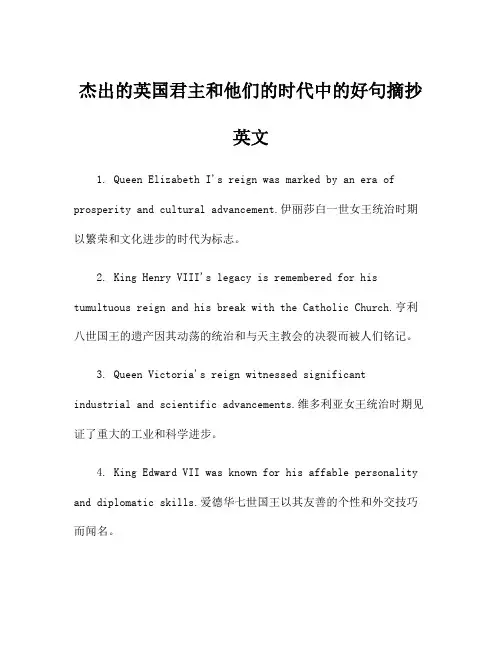
杰出的英国君主和他们的时代中的好句摘抄英文1. Queen Elizabeth I's reign was marked by an era of prosperity and cultural advancement.伊丽莎白一世女王统治时期以繁荣和文化进步的时代为标志。
2. King Henry VIII's legacy is remembered for his tumultuous reign and his break with the Catholic Church.亨利八世国王的遗产因其动荡的统治和与天主教会的决裂而被人们铭记。
3. Queen Victoria's reign witnessed significant industrial and scientific advancements.维多利亚女王统治时期见证了重大的工业和科学进步。
4. King Edward VII was known for his affable personality and diplomatic skills.爱德华七世国王以其友善的个性和外交技巧而闻名。
5. Queen Elizabeth II is the longest-reigning British monarch in history.伊丽莎白二世女王是历史上在位时间最长的英国君主。
6. King James I's reign saw the publication of the famous King James Version of the Bible.詹姆斯一世国王统治时期出版了著名的《英王詹姆斯版圣经》。
7. Queen Mary I's reign was marked by her efforts to restore Catholicism in England.玛丽一世女王统治时期以她努力恢复英国天主教的努力而闻名。
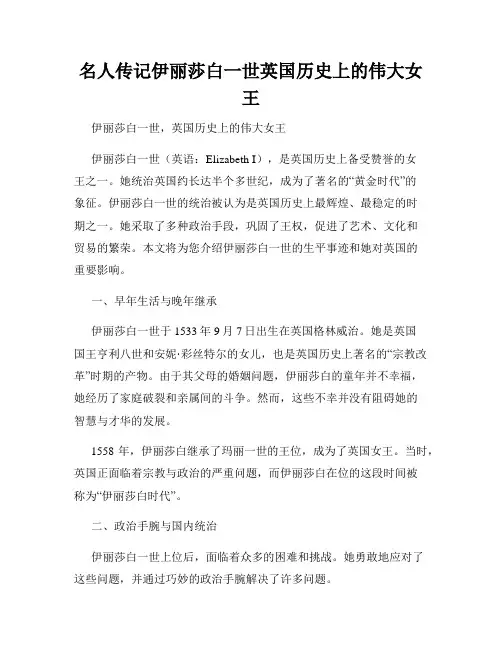
名人传记伊丽莎白一世英国历史上的伟大女王伊丽莎白一世,英国历史上的伟大女王伊丽莎白一世(英语:Elizabeth I),是英国历史上备受赞誉的女王之一。
她统治英国约长达半个多世纪,成为了著名的“黄金时代”的象征。
伊丽莎白一世的统治被认为是英国历史上最辉煌、最稳定的时期之一。
她采取了多种政治手段,巩固了王权,促进了艺术、文化和贸易的繁荣。
本文将为您介绍伊丽莎白一世的生平事迹和她对英国的重要影响。
一、早年生活与晚年继承伊丽莎白一世于1533年9月7日出生在英国格林威治。
她是英国国王亨利八世和安妮·彩丝特尔的女儿,也是英国历史上著名的“宗教改革”时期的产物。
由于其父母的婚姻问题,伊丽莎白的童年并不幸福,她经历了家庭破裂和亲属间的斗争。
然而,这些不幸并没有阻碍她的智慧与才华的发展。
1558年,伊丽莎白继承了玛丽一世的王位,成为了英国女王。
当时,英国正面临着宗教与政治的严重问题,而伊丽莎白在位的这段时间被称为“伊丽莎白时代”。
二、政治手腕与国内统治伊丽莎白一世上位后,面临着众多的困难和挑战。
她勇敢地应对了这些问题,并通过巧妙的政治手腕解决了许多问题。
首先,伊丽莎白一世积极推行和平宗教改革,将国家由天主教转变为英国国教(圣公会)。
她的这一举措为英国带来了宗教和谐,缓解了早期宗教冲突。
其次,伊丽莎白一世精于外交,并维持了与欧洲国家的良好关系。
她通过外交手段,确保了英国在欧洲的稳定地位,并且成功地阻止了西班牙无敌舰队的入侵。
此外,伊丽莎白一世还推动了英国的经济发展。
她倡导贸易、航海和探险,并资助了许多航海家探索未知的领土。
这一时期被誉为英国的“航海时代”,为英国带来了巨大的财富和国威。
三、文艺复兴与文化繁荣伊丽莎白一世对文学、艺术和戏剧的支持也为英国带来了文化的繁荣。
著名的莎士比亚就是在她的统治时期崭露头角的。
伊丽莎白一世本人也是一位文学爱好者,她鼓励和赞赏文学家和艺术家的创作,并成立了皇家剧院来推广戏剧表演。


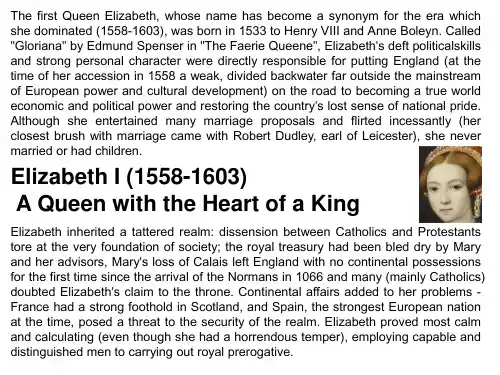
英国历代君主世系表一、诺曼王朝The House of Norman1、威廉一世King William I the Conqueror “征服王”(法文:Guillaume le Conquérant; 英语:King William I The Conqueror;拉丁文:Willielmus Rex Anglorum,1028年9月-1087年9月9日)诺曼底公爵(1035年-1087年)、英格兰国王(1066年-1087年在位)。
2、威廉二世·鲁弗斯King William II Rufus "红毛王"(英文名William II Rufus,约1056年~1100年8月2日),英格兰国王,由1087年到1100年在位。
3、亨利一世King Henry I Well-Educated, Beauclerc "儒雅王"(1068年—1135年12月1日),英格兰诺曼底王朝国王(1100年—1135年在位)。
4、斯蒂芬(King Stephen) (布洛瓦王朝)(英文名Stephen,1096年~1154年10月25日),英格兰国王,由1135年到1154年在位。
——————————二、安茹王朝The House of Anjou1、亨利二世King Henry II Curtmantle "短斗篷王"(1133年3月25日—1189年7月6日)是英格兰国王(1154年—1189年在位),他也是法国的诺曼底公爵(1150年起)、安茹伯爵(1151年起)和阿基坦公爵(1152年起)。
2、理查一世King Richard I Coeur de Lion "狮心王"(Richard I,1157年9月8日-1199年4月6日)英国金雀花王朝的第二位国王,他在位期为1189年至1199年。
3、约翰King John Lackland "无地王"(英文名John,1166年或1167年12月24日~1216年10月18日或19日)英格兰国王,由1199年到1216年在位。
英国女王伊丽莎白一世伊丽莎白一世(英语:Queen Elizabeth I)是英国历史上一位具有重要影响力的君主。
她在位期间,成为了伟大的女王,并且对英国的政治、文化和宗教产生了深远的影响。
本文将从伊丽莎白一世的个人生平、政治才能和对英国的遗产等方面,全面介绍这位杰出的女性君主。
伊丽莎白一世于1533年出生在英国格林威治宫。
她是亨利八世与安妮·博林的女儿,也是玛丽一世的妹妹。
伊丽莎白的童年并不幸福,她经历了父亲的离婚、母亲的被处决以及姐姐玛丽的迫害。
然而,这些经历锻造了她坚强的性格,并为她日后的统治打下了基础。
伊丽莎白一世于1558年登上英格兰王位,成为了历史上最著名的英国女君主之一。
她的政治才能使她成为了一位睿智和有效的统治者。
她实行了一系列内外政策,她的统治被称为“伊丽莎白时代”。
首先,伊丽莎白一世采取了巧妙的外交手段,确保了英国在欧洲的地位。
她经历了与西班牙的长期战争,包括有名的“无敌舰队”战役,最终成功地击败了西班牙。
这次胜利巩固了英国作为一个独立国家的地位,并且为英国的殖民扩张做出了贡献。
其次,伊丽莎白一世实行了一系列内政改革,促进了英国的繁荣和文化的繁荣。
她支持探险家的航海探险,在她的统治下,一些伟大的航海家如弗朗西斯·德雷克(Francis Drake)和沃尔特·罗利(Walter Raleigh)带领船队探索了新的领土。
这些航海家的探险为英国带来了财富和海外殖民地。
伊丽莎白一世还鼓励了艺术和文学的发展。
著名的作家威廉·莎士比亚在伊丽莎白一世的庇护下开始创作,并为英国文学作出了重要贡献。
她的政府还支持了剧院的建设和戏剧的发展,为英国戏剧史书写了辉煌的一页。
此外,伊丽莎白一世实行了一系列宽容政策,试图解决宗教问题。
她的统治时期正值宗教改革时期,英国社会分裂严重。
她采取了妥协的姿态,通过制定“女王至上法案”来确立自己作为国家统一的象征,既不彻底改革,又不回归天主教。
伊丽莎白一世的语录伊丽莎白一世(Queen Elizabeth I)是英国历史上一位杰出的女王,统治时期被称为“伊丽莎白时代”,她以她的智慧、果决和领导才能成为了伟大的英国君主。
以下是一些伊丽莎白一世的语录,它们准确地反映了她的个性和治国原则。
1. “我已经在一个女人的身体里发现了所有的皇帝和国王。
”这句话展现了伊丽莎白一世对自身的自豪和自信。
她坚信自己有能力胜任君主的角色,尽管当时女性在政治上的地位相对较低。
2. “我显然是女性,但我有着心地坚定的意志。
”伊丽莎白一世因她的毅力和坚定的决心而闻名。
她的这句话表达了她对自己性别的承认,但强调了她在统治国家方面的决心和能力。
3. “我宁愿拥有一个英国人的心灵,而不是一个法国人的灵魂。
”这句话体现了伊丽莎白一世的爱国主义情感。
作为一位英国君主,她对她的国家充满了自豪和忠诚。
4. “与害怕损失自由的人相比,我更害怕失去我的生命。
”伊丽莎白一世对自由的珍视表达在这句话中,她坚信自由是最宝贵的财富,甚至比生命本身更重要。
5. “我对我的人民是父亲,他们对我是孩子。
虽然我渴望拥有一个男子的心,我无比珍惜被我的人民爱戴。
”这句话展现了伊丽莎白一世对她所统治的人民的关心和照顾,她把自己比作父亲,把人民比作自己的孩子,强调了君主与人民之间的特殊关系。
6. “我是英国的君主,我宽容却不会忍受背叛。
”这句话彰显了伊丽莎白一世的仁慈和宽容,但同时也表明了她对背叛的零容忍态度。
7. “我要求不过是一个女人的心,配以男人的胆量。
”伊丽莎白一世强调自己有女性的情感和智慧,但也拥有坚韧和勇气,她坚信这是一个好的君主所应具备的品质。
8. “如果我是你们,我也会为我付出的一切感到自豪。
”这句话彰显了伊丽莎白一世对她的臣民的赞赏和感激之情。
她认为自己所做的一切是值得的,并希望臣民也能对自己的国家和付出感到自豪。
9. “我希望世界上永远只有一个宗教,因为那样会更容易统治。
”伊丽莎白一世对统治的追求在这句话中得以体现。